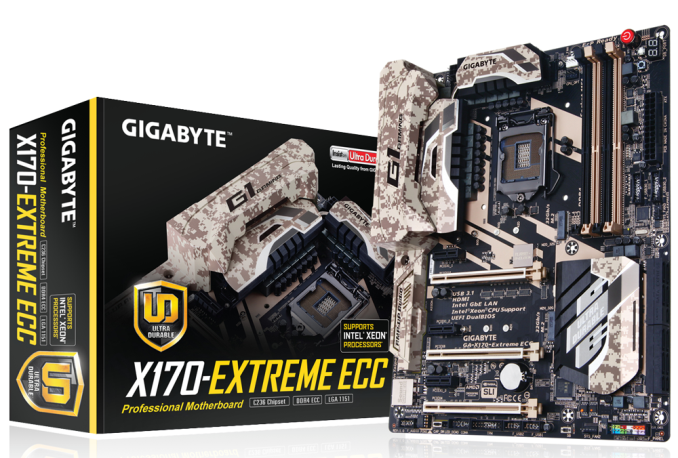The GIGABYTE X170-Extreme ECC Motherboard Review: For When Skylake Xeons need SLI and Thunderbolt 3
by Ian Cutress on October 17, 2016 2:00 PM ESTGIGABYTE X170-Extreme ECC Conclusion
When GIGABYTE announced its X170 line of motherboards with server chipsets back at CES in January 2016, I was relatively skeptical. Here was a prosumer product with an odd name (there's no X170 chipset for a start), in camouflage attire being marketed to consumers. A number of motherboard companies had approached me questioning the size of the mainstream Xeon market (ie the E3-1200 market), but GIGABYTE nevertheless went in feet first with this design. Alongside the big X170-Extreme ECC we've looked at in this review, there is also a C232 based ATX version and a micro-ATX in the same family. Nonetheless the X170-Extreme ECC is the only one motherboard on the market that supports SLI, Thunderbolt 3 and Xeon CPUs all at the same time.
Asking around about the prevalence of SLI in the E3-1200 Xeon market, and most motherboard manufacturers dismissed it as a small number. The answer I got most of the time is that any user that requires 2+ GPUs is typically doing so in OpenCL mode, not for gaming, which wouldn't require SLI. As an example I was cited a handful of C236 motherboards that support x8/x8 via bifurcation of the CPU PCIe lanes.
For the GIGABYTE X170-Extreme ECC, if you need SLI with Thunderbolt 3 and a Skylake E3-1200 v5 Xeon, it is your only option. Nonetheless, it still comes across as a well-equipped motherboard, and excels in some of our benchmarks, such as POST time where it tops the table. Unfortunately the are some tumbles, such as the DPC Latency at 250 microseconds.
$310 is still a lot for a motherboard. Bearing that in mind, and that we have awarded $500 motherboards this generation, it is clear where the GIGABYTE X170-Extreme ECCs selling points lie. If you want a server grade chipset with ECC and SLI support, as well as Thunderbolt 3, this is one of the few off the shelf options available. Unlike most server offerings (like the MW31-SP0), it behaves with the user experience of a similarly priced consumer product, which is what we used to expect before Intel made the transition for Xeon E3 CPUs to enterprise chipsets only.
Other 100-Series and C232/C236 Motherboard Reviews:
Prices Correct at time of each review
$500: The GIGABYTE Z170X-Gaming G1 Review [link]
$500: The ASUS Maximus VIII Extreme Review [link]
$370: The GIGABYTE Server MW31-SP0 (C236) Review [link]
$310: The GIGABYTE X170-Extreme ECC Review [this review]
$250: The ASUS Maximus VIII Impact Review [link]
$240: The ASRock Z170 Extreme7+ Review [link]
$230: The MSI Z170 Gaming M7 Review [link]
$208: The GIGABYTE Z170-UD5 TH Review [link]
$165: The ASUS Z170-A Review [link]
$143: The ASRock E3V5 Gaming (C232) Review [link]
$130: The MSI Z170A SLI PLUS Review [link]
$125: The Supermicro C7H170-M Review [link]











31 Comments
View All Comments
SetiroN - Monday, October 17, 2016 - link
There is only one thing that's worse than camo: pixelized camo.I honestly fail to understand who in the world would ever buy a socket 1150 Xeon solution instead of socket 2011.
dave_the_nerd - Monday, October 17, 2016 - link
1) Digital camo has been standard-issue in the military for a while now.2) Anybody who only needs a 4c/8t system, but is otherwise doing "workstation" or server-grade work. (Uptime requirements, longevity requirements, need ECC ram for data crunching, need virtualization features, etc.)
zepi - Monday, October 17, 2016 - link
4c/8t LGA2011 solution hardly costs much more, especially since this board is approaching the pricing of workstation mobos...Einy0 - Monday, October 17, 2016 - link
2) The supposed advantages are 95% marketing. Uptime is more about your OS if you select quality components to go with the CPU. Longevity, seriously??? I can show you desktops built 30+ years ago that run today the same as they did then. How many CPUs actually die? I personally have had one die, it was 7 years old. Virtualization, again no more features on the 1151 Xeon versus the i7. ECC, that's the one feature an 1151 Xeon has over a similar i7. Now when we start talking multi-socket and what not well that's obvious. I've had these conversations in the past with engineers and developers at work. Everyone just assumes that when Intel says they need a Xeon to do something there is a reason. Yup, there is a reason, they can make more money from the same chip with a Xeon badge on it.HollyDOL - Tuesday, October 18, 2016 - link
Yep, you can show 30 old desktops still working, but how many of them were running 24/7? None.mkaibear - Tuesday, October 18, 2016 - link
Up until very recently I had a desktop of about that vintage running SCO Unix. That ran 24/7. In fact we were scared to turn it off because it ran chunks of the factory...devol - Saturday, October 22, 2016 - link
There are more differences than just ECC memory. For instance i7 cpu's don't support hugetlb/hugepages, and several other 'server' focused virtualization extensions. Until Skylake though, the PCH had basically no support for needed features for SR-IOV.bigboxes - Monday, October 17, 2016 - link
I'm sorry. I can't see the motherboard. Where is it in the picture?stardude82 - Friday, November 18, 2016 - link
I think it's generally acknowledged now that the digital camouflage was a failure.https://en.wikipedia.org/wiki/MultiCam#United_Stat...
BrokenCrayons - Monday, October 17, 2016 - link
Yeah, it's really off-putting to see camo. I think they're going for some kind of military/tactical thing, but Gigabyte's failed to realize that camo just makes a product look trashy and redneck to people in the US these days.